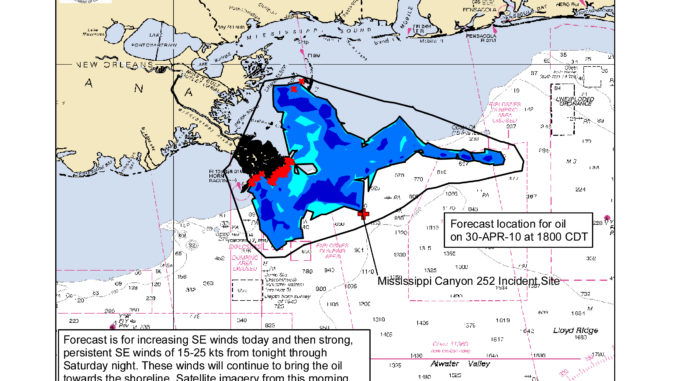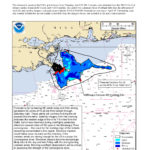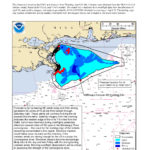
Can’t catch reds out of this popular port? Follow this guide, and you won’t be buying hamburgers and hot dogs for the barbecue pit.
Oil from the destroyed Deepwater Horizon began making landfall last night (April 29), the Associated Press reported.
The news agency reported that the first faint oily sheen could be seen “lapping” at the shoreline, and a National Oceanic and Atmospheric Administration forecast calls for the main slick to wrap around the mouth of the Mississippi River by this evening.
Louisiana Rep. Charlie Melancon (D-Napoleonville) said on Baton Rouge’s WAFB-TV this morning that he was set to overfly the coast today with Department of Homeland Security Secretary Janet Napolitano, Department of the Interior Secretary Ken Salazar and Environmental Protection Agency Administrator Lisa Jackson.
Melancon said protective boom already was in place in many areas of the coast, although currently only 32 miles of boom had been authorized.
“They are laying boom, focusing on …rookeries and the other sensitive areas,” Melancon said.
Click here for a map showing where containment boom has thus far been positioned along the Louisiana, Mississippi, Alabama and Florida coastlines.
NOAA reported that another 46 miles is available and an additional 50 miles has been ordered to bring the total boom that could eventually be deployed to 128 miles.
Melancon said pressure is building for more boom to be laid to protect interior marshes, but admitted time is of the essence.
“That’s going to be the element, getting it done on time,” Melancon said.
Locally, Gov. Bobby Jindal has declared a state of emergency while on a federal level Pres. Barak Obama has reportedly ordered the Navy to the scene to help with skimming and containment.
Melancon expressed frustration many feel over the federal response, but he admitted it’s a disaster of unprecedented proportions.
“We’re back to some of the (response) problems we had with Hurricane Katrina,” Melancon said. “This is more than an oil spill. This is an open spigot in the bottom of the Gulf that may be open and running for months to come.”
An estimated 210,000 gallons (5,000 barrels) are spewing from the destroyed oil well each day, and it will take only 55 days to surpass the almost 11 million gallons during the Exxon Valdez disaster in 1989.
U.S. Coast Guard Rear Admiral Sally Brice-O’Hara said on ABC’s Good Morning America this morning that weather is preventing work to stop the main slick’s movement toward the coast.
“We will continue with the operations on the surface, using dispersants, skimming and the controlled burns – but the last two, skimming and controlled burns are highly dependent upon the weather and we won’t be able to use them in the next couple of days,” Brice-O’Hara said.
But she defended the federal response, which many have criticized and compared to the delayed response after Hurricane Katrina.
“The federal response to this has been immediate and sustained, and we have scaled as we learned more about the situation we are dealing with,” Brice-O’Hara said. “We are working closely with the responsible party (BP), and they have brought a number of technologies to bear to try to get these leaks either repaired, capped or a relief valve in place.”
However, she repeatedly made references to BP taking action with little mention of what the federal government is doing to save the coast from what looks to be an ecological disaster.
“As we watch the trajectory, we see a threat to the Louisiana shoreline, so our focus has been that the responsible party get the necessary boom in place, be ready to go with work boats, with workers, with volunteers … so we have a coordinated and very strong team in place to deal with the oil as it comes onshore,” Brice-O’Hara said.
For their part, BP reaffirmed its commitment to stopping the leaking oil, including the injection of oil dispersants to the leak locations.
“We want to pursue every technique we can find in parallel because we don’t know which one will work,” BP Exploration and Production Chief Operations Officer Doug Suttles said on GMA.
No fishing closures have been reported, but anglers are cautioned that running through any oil slick could damage their outboards.
“Yeah, you can run through (the oil sheen), but if you’ve got a water-cooled engine that oil runs through your engine,” Cypress Cove Marina’s Renee Cross told LouisianaSportsman.com yesterday. “If you get enough of that oil into the motor, it’s going to clog everything up.”
Click here for more on how devastating this oil spill could be on the fragile Louisiana marshes.




